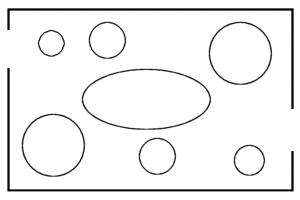Location is one of a very important factor in retail marketing strategies. Consequently, analysis of trade area for retail store allied with distinct planning with complex processes. Trade area analysis is a study of the contiguous geographic area to measure the key statistics affecting the store performance. The aim of this post is to demonstrate the concept and process of trade area analysis in retail marketing.
The concept: Trade Area Analysis
Trade area analysis is a method, technique or study to provide an understanding and visualizing the approximate extent and scope of a geographic area for trading. This analysis also helps to make available the information like store backing, local market opportunities, competitive data, and barriers that would discourage consumers from visiting the site.
A trade area may include a city, district, state, country or even beyond the country for international retail business strategies.A figure below indicates the layers of trade areas:
· Primary area: Highest store customer’s density (approx. 60-80%)
· Secondary area: Medium store customer’s density (approx. 10-20%)
· Territory area: Lowest store customer’s density (remaining)
Approaches to Trade Area Analysis:
1. GIS Mapping Software:
Geographic Information System (GIS) is a digital mapping software which provides a geographical data with mapping techniques to select the trade location accurately. It combines the mapping with data for key locations to the graphical view including demographic factors of population, data on customer purchase and competitor’s data. Currently, there is more such software are available in the market.
2. Radial Analysis:
Radial or ring-based analysis is the easiest method of trade area analysis in retail. This analysis assumes that the trade area is round or a ring and store are located in the center of this ring. It is executed by calculating demographic variables that fall in the selected circular area from the store.
Above image of the radial, the analysis indicates the store located at the center of the ring. Dots are the demographic sites. Red dots are fallen within 5 miles of radius.
3. Gravity Model:
A gravity model of trade was firstly presented by Jan Tinbergen in 1962. It is based on bilateral trade flows between two different geographical distances can be measured by applying Newton’s gravity equation. This model suggests that two relative economic distances attract each other to trade. Below is the equation of gravity model:
1st Area population * 2nd Area population / Distance between Area
4. Drive Time Analysis:
This is GIS-based analysis to indicate that how many people live within 30 minutes of drive time from a store? It also helps to calculate the overlap between the distances measured in time from the store. It is most recent trending and used software to analyze trade area. It is a study of the road network which combines the advanced digital GIS modeling technology to gives an accurate data.
Above image of drive time analysis showing areas that can be reached within 5, 10 and 15-minute drive times from the selected store location.









